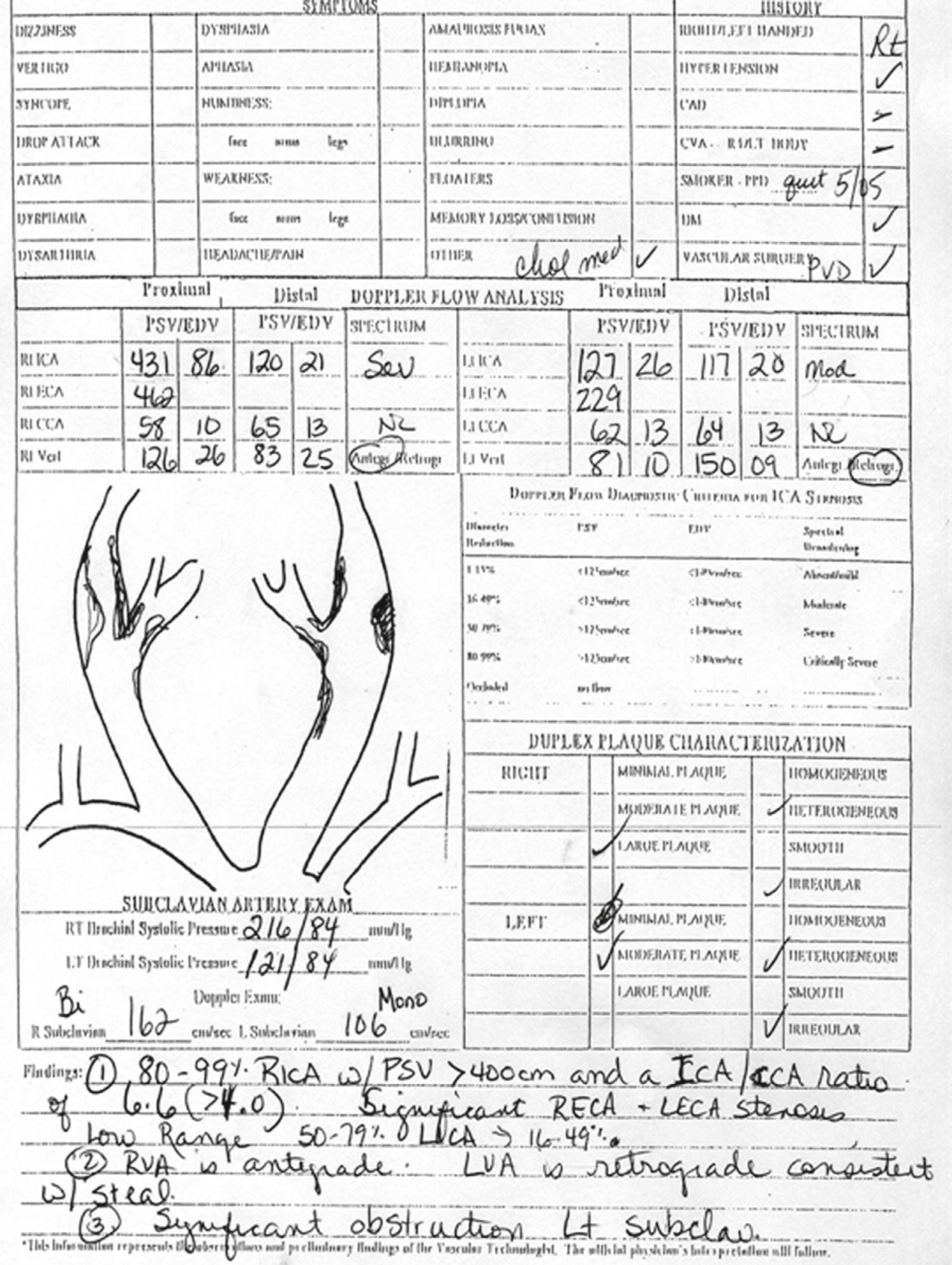Physical Address
304 North Cardinal St.
Dorchester Center, MA 02124
Fourth most common cause of death in the United States
One million hospital admissions/year
Significant neurologic morbidity
Risk factors for stroke
Nonmodifiable
Sex (male)
Age (>55 years)
Race (African American)
Family history
Modifiable
Hypertension—preeminent risk factor
Smoking
Obesity
Physical inactivity
Diet
Diabetes
Hypercholesterolemia
Alcohol
Renal insufficiency
Etiologies of stroke
Ischemic—insufficient blood supply
Embolic (two-thirds of ischemic strokes)—clot or plaque formation outside of the cerebral vasculature
Carotid embolization —cholesterol or fibrin/platelet matter
Cardiogenic embolization—valvular disease, atrial fibrillation
Hematologic causes—hypercoagulability disorders
Thrombotic
Local in situ occlusion of cerebral vessels, or
Carotid thrombosis
Circle of Willis collateralizes in response.
Chronicity and extent of thrombosis may determine symptoms.
Acute flow impairment may occur (e.g., a hypotensive event).
Hemorrhagic—10%–15% of strokes
Intracranial hemorrhage caused by trauma, among other factors
Rupture of cerebral aneurysm
Definition of transient ischemic attack
Commonly referred to as mini-stroke
Strokelike symptoms lasting less than 24 hours
Warning signs for stroke
A total of 30% of patients with a transient ischemic attack (TIA) will go on to develop an ischemic stroke in 5 years.
Although often lasting much less than 24 hours, infarction may have occurred.
Characteristics of neurologic symptoms—can localize a circulatory impairment (see Table 56.1 for a more complete review)
Onset—left leg weakness and speech difficulty
Provoking factors—none, onset is sudden and unexplained
Palliative factors—none, resolves with time
Timing differentiates between TIA and stroke—majority of TIAs last less then 6 hours.
Associated symptoms
Pertinent negatives—denies nausea, vomiting, fevers, chest pain, or chest palpitation
| Symptoms | Vascular Distribution | Neurologic Distribution |
|---|---|---|
| Transient monocular blindness (amaurosis fugax) | ||
| Visual field disturbances | Retinal artery | Limited to the ipsilateral retina/eye |
| Altered mental status | ||
| Impaired judgment | ||
| Contralateral motor weakness | Anterior cerebral artery | Cerebral hemisphere |
| Loss of sensation | ||
| Speech/language deficits | ||
| Visual field deficits | Middle cerebral artery | Cerebral hemisphere |
| Hemianopsia | ||
| Impaired memory | Posterior cerebral artery | Cerebral hemisphere |
| Dysarthria, dysphagia, diplopia | ||
| Limb or gait ataxia | ||
| Simultaneous motor, sensory, and visual loss | Vertebrobasilar | Brainstem, cerebellum, cerebrum |
Medical history—risk factor assessment including hypertension, diabetes, and coronary disease
Surgical history
Three-vessel coronary artery bypass grafting 2 years ago
Guidelines recommend carotid evaluation in the preoperative work-up of selected high-risk potential coronary bypass patients.
Allergies/medications—no known drug allergies; currently taking atenolol, metformin, lisinopril, and aspirin
Social history—nonsmoker, quit 10 years ago; drinks alcohol socially; no recent travel
HEENT (head, eyes—presence of Hollenhorst plaque does not increase the risk of TIA or stroke, ears, nose, and throat)
There are no carotid bruits bilaterally.
The presence of a carotid bruit has low sensitivity for detecting more than 70% stenosis.
Amaurosis fugax alone is associated with the same stroke risk as a TIA.
Cardiovascular
Rate and rhythm are regular, with no murmurs.
Evaluate pulse and murmurs for possible cardiac sources of emboli.
Pulmonary—clear bilaterally
Abdomen—no palpable masses or audible periumbilical bruits
Vascular
Two plus carotid, radial, femoral, popliteal, and dorsalis pedis pulses bilaterally
A full vascular examination is important to diagnose other possible pathologic conditions, including aneurysms.
Neurologic
Cranial nerves II–XII intact. 5 of 5 strength in all upper and lower extremity muscle groups. No evidence of hyperreflexia
A full neurologic examination may help to identify symptoms in active stroke and localize a lesion.
Carotid duplex ultrasound ( Fig. 56.1 )
Advantages
Noninvasive
Can give information on velocities, anatomy, and plaque morphology
Can achieve high sensitivity (>75%) and specificity (>95%) if combinations of parameters are measured ( Table 56.2 ).
Contralateral stenosis/occlusion can falsely elevate velocities; low cardiac output can influence velocities
| Degree of Stenosis of the Internal Carotid Artery | Peak Systolic Velocity | End-Diastolic Velocity | Internal Carotid Artery/Common Carotid Artery Ratio |
|---|---|---|---|
| Normal <50% | <125 | <40 | <2.0 |
| Between 50%–70% | 125–230 | 40–100 | 2.0–4.0 |
| >70% | >230 | >100 | >4.0 |
| Occluded | Undetectable | N/A | N/A |
Disadvantages: Ultrasound is limited by the following factors:
Operator dependence
Tortuous vessels
Visualizations of proximal common carotid or intracranial branches
Arterial calcification

Computed tomographic angiography
Advantages
Anatomy of the arch—important planning for carotid stenting
Demonstrates relative position of calcifications and stenosis near the carotid bifurcation
Provides an estimate of the residual lumen and less likely to overestimate stenosis
Disadvantage—requires a contrast bolus comparable to that of angiography
Magnetic resonance angiography
Advantages
Avoids nephrotoxic contrast agents
May allow characterization of plaque morphology
Disadvantages
Can overestimate stenosis
Incompatible with implanted metallic devices
Claustrophobia
Angiography—no longer the gold standard
Advantages
Used mostly in the case of conflicting results between two other imaging techniques
Evaluation of entire carotid system including collaterals and the aortic arch
Necessary for patients undergoing carotid artery stenting (CAS)
Disadvantages
Invasiveness and cost
Neurologic and vascular morbidity (risk of stroke or TIA can be as high as 1.3%)
Limited views
Comprises 90% of carotid occlusive disease cases
Anatomy influences hemodynamics—formation of plaque on lateral walls
Pathophysiology
Hyperlipidemia, hypertension, diabetes, and so on, lead to endothelial injury.
Monocytes driven by more low-density lipoproteins adhere to and invade the damaged endothelium.
Plaque size increases.
Increased platelet activity furthers endothelial damage.
Platelets stimulate intimal smooth muscle cells to secrete extracellular matrix.
Muscle cells accumulate lipids, and the plaque center becomes necrotic.
Plaque ulceration and rupture are similar to acute coronary syndrome.
Become a Clinical Tree membership for Full access and enjoy Unlimited articles
If you are a member. Log in here